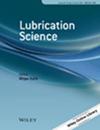Effect of LaF3 on the Properties of Pb-Free Cu-Based Self-Lubricating Composites
Abstract
A strategy involving the use the rare-earth compound LaF3 with good lubrication and stability properties as a filler in the preparation of Cu-based composites was proposed to solve the problem of poor wear resistance in Pb-free Cu-Bi materials. The influence and regulatory mechanism of LaF3 content on the mechanical and tribological properties of these composites were studied. The results indicate that LaF3 has a good refining effect on Cu alloy grains, and LaF3 and Bi are distributed in a network along the grain boundaries of the Cu alloy in the material. As the LaF3 content increases, the mechanical properties and friction coefficient of the composite gradually decrease, and the wear rate first declines and then increases. The wear resistance of Cu-Bi composite containing LaF3 mainly depends on the mechanical support provided by the matrix. When the LaF3 content is higher than 6%, the composite strength is extremely low, and the increase in lubricant content at the friction interface does not play a decisive role in the material wear behaviour. The material wear rate increases with the increase in LaF3 content. Therefore, using 6% LaF3 is recommended to improve the wear resistance of the material and maintain a balance among its mechanical properties, antifriction and wear resistance.

 求助内容:
求助内容: 应助结果提醒方式:
应助结果提醒方式:


